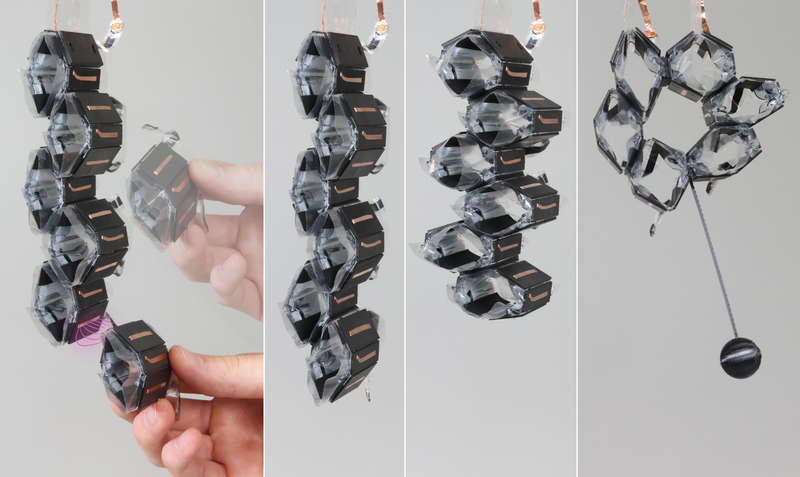Reviewed by Lexie CornerSep 19 2024
Researchers at the Max-Planck-Institute for Intelligent Systems have developed hexagon-shaped robotic modules that can be assembled like LEGO pieces to create fast, modular robots with interchangeable components. Scientists from the MPI-IS Robotic Materials Department combined artificial muscles with magnet-embedded hexagonal exoskeletons, enabling rapid mechanical and electrical connections. The study was published in Science Robotics.
 HEXEL modules snap together to form a large-stroke muscle and a multi-modal array. Image Credit: Max-Planck Institute for Intelligent Systems.
HEXEL modules snap together to form a large-stroke muscle and a multi-modal array. Image Credit: Max-Planck Institute for Intelligent Systems.
Each HEXEL module consists of an exoskeleton made of six lightweight, stiff plates of glass fiber. The inner joints of the hexagons are powered by Hydraulically Amplified Self-healing Electrostatic (HASEL) artificial muscles. When a high voltage is applied, the muscle contracts, rotating the hexagon's joints and transforming its shape from long and narrow to wide and flat.
Combining soft and rigid components in this way enables high strokes and high speeds. By connecting several modules, we can create new robot geometries and repurpose them for changing needs.
Ellen Rumley, Visiting Researcher and Study Co-Author, University of Colorado Boulder
Ellen Rumley and Zachary Yoder are both Ph.D. students working in the Robotic Materials Department.
In a video, the team demonstrates the diverse range of behaviors achievable with HEXEL modules. A single module can actuate fast enough to leap into the air, while a cluster of modules can compress to squeeze through a narrow opening. The configuration of the modules allows for versatile movements; for instance, the researchers combined several pieces to build a robot capable of rolling quickly.
In general, it makes a lot of sense to develop robots with reconfigurable capabilities. It is a sustainable design option—instead of buying five different robots for five different purposes, we can build many different robots by using the same components. Robots made from reconfigurable modules could be rearranged on demand to provide more versatility than specialized systems, which could be beneficial in resource-limited environments.
Zachary Yoder, Ph.D. Student, Robotic Materials Department, Max Planck Institute for Intelligent Systems
Hexagonal electrohydraulic modules for rapidly reconfigurable high-speed robots
Video Credit: Max-Planck-Institute for Intelligent Systems
Journal Reference:
Yoder, Z., et al. (2024) Hexagonal electrohydraulic modules for rapidly reconfigurable high-speed robots. Science Robotics. doi.org/10.1126/scirobotics.adl3546.